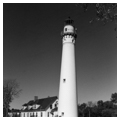In 1880, the Federal Lighthouse Board erected this light to help guide southbound ships into Racine Harbor. The conical brick tower rises 108 feet from a stone foundation, tapering from a 22-foot-diameter to a little less than 13 feet. The ten-sided cast-iron lantern crowning the light originally flashed a white coastal light and a red light, which warned ships around Racine Reef. Both beacons had a third-order Fresnel lens. Twice daily, the keeper climbed the spiral staircase’s 142 steps, lugging two five-gallon cans of kerosene to keep the lamps lit. In 1924 the light was electrified, and in 1964 it was automated. In times of dense fog, the keeper would dash to the brick Signal Building, built in 1900 at the lake, to blare a loud warning horn. The fog horn was dismantled in 1964, and its building is now a maritime museum. Several auxiliary buildings complete the site. The lighthouse keeper and his two assistants lived in the Keeper’s House, a rambling clapboard building with hipped dormers. It is connected to the tower by a covered passageway.
You are here
Wind Point Light Station (Racine Point Light Station)
If SAH Archipedia has been useful to you, please consider supporting it.
SAH Archipedia tells the story of the United States through its buildings, landscapes, and cities. This freely available resource empowers the public with authoritative knowledge that deepens their understanding and appreciation of the built environment. But the Society of Architectural Historians, which created SAH Archipedia with University of Virginia Press, needs your support to maintain the high-caliber research, writing, photography, cartography, editing, design, and programming that make SAH Archipedia a trusted online resource available to all who value the history of place, heritage tourism, and learning.





